Kingdom of Norway (872–1397)
| Kingdom of Norway Norwegian Realm
| |||||||||||||
|---|---|---|---|---|---|---|---|---|---|---|---|---|---|
| 872–1397 | |||||||||||||
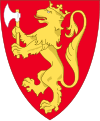 Coat of arms used from the 13th century
| |||||||||||||
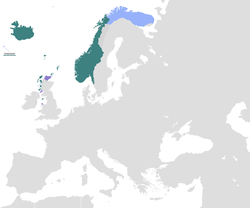 Norway at its greatest extent, around 1263 | |||||||||||||
| Status | Greater Norway: 1027a–1397b | ||||||||||||
| Capital |
| ||||||||||||
| Common languages |
Majority languages:
Other languages:
Lingua franca:
Writing system:
| ||||||||||||
| Religion |
State religion:
Other religion:
| ||||||||||||
| Demonym | Norwegian | ||||||||||||
| Government | Feudal monarchy | ||||||||||||
| Monarch | |||||||||||||
• 872–932 | Harald I first | ||||||||||||
• 1387–1397 | Margaret I last | ||||||||||||
| Legislature |
Council of Realm c. 1300 – 1397 | ||||||||||||
| Historical era | Middle Ages | ||||||||||||
• Established | 872 | ||||||||||||
• Disestablished | 1397 | ||||||||||||
| Area | |||||||||||||
| 1263c | 2,322,755 km2 (896,821 sq mi) | ||||||||||||
| Currency |
Norwegian penning 995–1397 | ||||||||||||
| ISO 3166 code | NO | ||||||||||||
| |||||||||||||
| Today part of |
Tax territory | ||||||||||||
The term Norwegian Realm (Old Norse: Norégveldi, Bokmål: Norgesveldet, Nynorsk: Noregsveldet) refer to the Kingdom of Norway's peak of power at the 13th century after a long period of civil war before 1240. The kingdom was a loosely unified nation including the territory of modern-day Norway, modern-day Swedish territory of Jämtland, Herjedalen, Ranrike and Idre and Särna, as well as Norway's overseas possessions which had been settled by Norwegian seafarers for centuries before being annexed or incorporated into the kingdom as 'tax territories'. To the North, Norway also bordered extensive tax territories on the mainland. Norway, whose expansionalism starts from the very foundation of the Kingdom in 872, reached the peak of its power in the years between 1240 and 1319.
At the peak of Norwegian expansion before the civil war (1130–1240), Sigurd I led the Norwegian Crusade (1107–1110). The crusaders won battles in Lisbon and the Balearic Islands. In the Siege of Sidon they fought alongside Baldwin I and Ordelafo Faliero, and the siege resulted in an expansion of the Kingdom of Jerusalem.[1]. Leif Erikson, an Icelander of Norwegian origin and official hirdman of King Olaf I of Norway, explored America 500 years before Columbus[2]. Adam of Bremen wrote about the new lands in "Gesta Hammaburgensis ecclesiae pontificum" (1076) when meeting Sweyn I of Denmark, but no other sources indicate that this knowledge went farther into Europe than Bremen, Germany. The Kingdom of Norway was the second European country after England to enforce a unified code of law to be applied for the whole country, called Magnus Lagabøtes landslov (1274).
The secular power was at its strongest at the end of King Haakon Haakonsson's reign in 1263. An important element of the period was the ecclesiastical supremacy of the archdiocese of Nidaros from 1152. There are no reliable sources for when Jämtland was placed under the archbishop of Uppsala. Uppsala was established later, and was the third metropolitan diocese in Scandinavia after Lund and Nidaros. The church participated in a political process both before and during the Kalmar Union that aimed at Swedish side, to establish a position for Sweden in Jämtland. This area had been a borderland in relation to the Swedish kingdom, and probably in some sort of alliance with Trøndelag, just as with Hålogaland.
A unified realm was initiated by King Harald I Fairhair in the 9th century. His efforts in unifying the petty kingdoms of Norway, resulted in the first known Norwegian central government. The country however fragmented soon, and was again collected into one entity in the first half of the 11th century. Norway has been a monarchy since Fairhair, passing through several eras.
History
When Harald Fairhair became king of Norway after the battle at Hafrsfjord (traditional date: 18 July 872), he looked west to the isles that had been colonised by Norwegians for a century already, and by 875 the Northern Isles of Orkney and Shetland had been brought under his rule and given to Ragnvald Eysteinsson, Jarl of Møre.
Iceland was more reluctant to give up their independent rule, so the Icelandic saga author Snorri Sturluson was given royal invitation to the court of King Haakon Haakonsson and was there convinced that Iceland was by right Norwegian. So began the Age of the Sturlungs, a time of political strife in Iceland, the Sturlungs worked for bringing Iceland to Norwegian rule and spread propaganda through their position at the Althing and even resorted to violence before, in 1262, the Old Covenant was signed, which brought total Norwegian rule over the island.
In Ranríki Konunghella was built as a royal city alongside Túnsberg and Biorgvin. It remained Norwegian until the 1658 Roskilde treaty. Herjárdalr became Norwegian during the 12th century and remained so for five centuries. Jamtaland started paying taxes to Norway during the 13th century and was later absorbed into a part of the mainland territory the same century. It was occupied by the Swedish during the Nordic Seven Years' War, but later returned to Denmark-Norway as a result of the Stettin treaty of 1570. Idre and Særna, Norwegian since the 12th century, were conquered by Sweden during the Hannibal controversy. Ranríki, Herjárdalr, Jamtaland, Idre and Særna were permanently surrendered to Sweden by the Peace of Brömsebro the 13th of August 1645.
Mainland
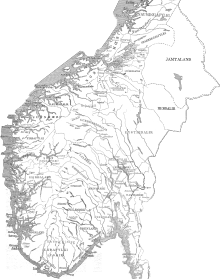
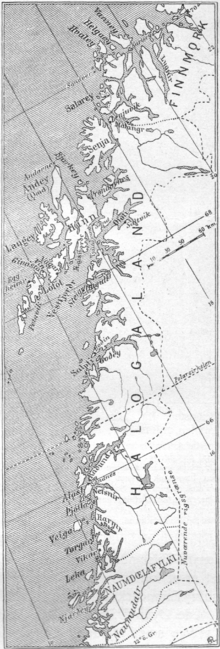
Administrative divisions
Viken, counties under Borgarþing:
- Ránríki
- Vingulmórk
- Vestfold
- Grenafylki (extending to Tvedestrand)
Oppland, counties under Heiðsævisþing:
- Heinafylki (current day Hedmarken and Gjøvik)
- Haðafylki (consisting of Hadeland, Land, Ringerike, and Toten)
- Raumaríki (consisting of Glåmdalen, and Romerike)
- Guðbrandsdalir
- Eystridalir (including Särna and Idre)
Vestlandet, counties under Gulaþing:
- Sunnmærafylki
- Firðafylki (consisting of Nordfjord and Sunnfjord)
- Sygnafylki
- Horðafylki
- Rygjafylki
- Egðafylki
- Vøllðres
- Haddingjadalr
Trøndelag, counties under Frostaþing:
- Raumsdølafylki
- Norðmørafylki
- Naumdølafylki
- Sparbyggjafylki
- Eynafylki
- Verdølafylki
- Skeynafylki
- Stjórdølafylki
- Strindafylki
- Gauldølafylki
- Orkdølafylki
Rest of Norway, counties not attached to a thing:
Tax territory
Expansion and unification
From the 600s Western Norwegian fish farmers began an exodus the nearby islands in the North Sea, Orkney and Shetland, later on to the Western Isles like the Hebrides and Man, and westward to the Faroe Islands, Iceland and Greenland. Some of these islands were inhabited when the Norwegians arrived, but the local population was displaced or assimilated by the Norwegian immigrants.
Consistently the islands' populations had a Norwegian ancestry, who kept in touch with the homeland over the North Sea. These Norwegian developed had their own chiefs or kings by Norwegian pattern, which was subject to the Norwegian royal power when it eventually got national authority. Often Norwegian kings had enough to contend with the mainland, so the local power in the villages were often in the hands of local earls who operated on behalf of the king.
Holdings in Sweden were in varying degrees Norwegian. At 800-900s it is reasonable to assume that the population of Båhuslen, Jämtland and Herjedalen had no national affiliation, neither of Norway, Svealand or Götaland. It lay to the increasingly centralized monarchy to create this, which had to consolidate its right in the border areas above the neighboring kingdoms. Norway was then the first to integrate these areas into its kingdom.
Overseas
Crown dependencies
- Ísland (Iceland)
- Grænland (Greenland)
- Færeyar (Faroe Islands)
- Mann (Isle of Mann)
- Hjaltland (Shetland)
- Orkneyar (Orkney Islands)
- Suðreyar (The Hebrides)
Iceland, Faroe Islands and Greenland remained under Norwegian administration until 1814.
The treaty of Perth (1266) accepted Norwegian sovereignty over Shetland and Orkney;
in turn Norway had to give the Hebrides and Isle of Man to Scotland.
Vassals
Vassals annexed by King Magnus III in 1098.
Ireland
Scotland
Wales
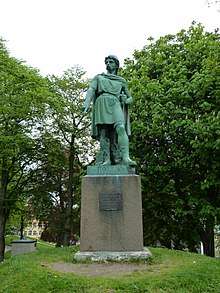
Other areas governed by Norwegians independent from the Empire
England
- Northumbria
Eric I of Norway ruled Northumbria for two separate periods. Northumbria has also been ruled by Norway under Cnut the Great, as well as West Norse people of the British Isles. The most important city was called Jórvík (York).
France
- Normandy
The Duchy of Normandy was ruled by Norwegian and Danish Vikings, under the leadership of Rollo. Following extensive raids on Paris and vast areas in France, the duchy was founded in 911. The main purpose was to gain land for independent Vikings in this region, therefore Rollo swore a vassalage under France rather than Norway or Denmark. Although Rollo's ancestry is disputed, it is now common among British, French and Norwegian scientists to have the opinion that, judging from the sources and the possible two alternatives, more sources point to Norwegian ancestry[9][10]. His descendant, William the Conqueror and his Norman army, would conquer England in 1066 after King Harald III of Norway had failed the same year.
Scotland
Monarchs of the hereditary kingdom
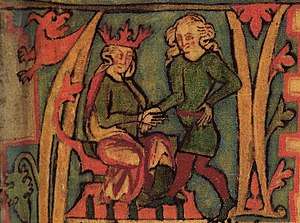
Yngling / Fairhair dynasty
_-_Foto_Giovanni_Dall'Orto%2C_29-March-2008.jpg)
Lade dynasty
Trygvason dynasty
Lade dynasty (restored)
Saint Olaf dynasty
Lade dynasty (restored, second time)
Saint Olaf dynasty (restored)
Hardrada dynasty
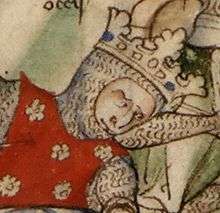
- Harald Sigurdsson
- Magnus II Haraldsson
- Olaf III Haraldsson
- Haakon Magnusson
- Magnus III Olafsson
- Olaf IV Magnusson
- Eystein I Magnusson
- Sigurd I Magnusson
- Magnus IV Sigurdsson
Gille dynasty
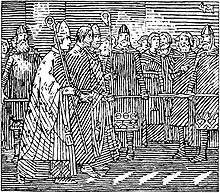
- Harald IV Magnusson
- Sigurd II Haraldsson
- Inge I Haraldsson
- Eystein II Haraldsson
- Magnus Haraldsson
- Haakon II Sigurdsson
Hardrada dynasty (female line)
Sverre dynasty
.jpg)
Gille dynasty (female line)
Sverre dynasty (restored)
Civil war era
Ancient and medieval aristocracy
Background
Orkney and Shetland
From the 7th century Norwegian farmers began to exodus from Rogaland and Agder to the nearby islands in the North Sea, Orkney and Shetland. These islands had long been undeveloped when the Norwegians arrived, the Picts, a possibly Celtic people who also stayed in mainland Scotland. The Norwegian the settlement resulted in the elderly population was gone, either because they were few and went back to relatives in Scotland, or because they were made slaves (thralls). Most place names on the islands are today of old Norwegian ancestry.
Old legends says that when Harald Fairhair had implemented their piratical expeditions for the national collection, these islands haunt for Vikings ravaged Norway. King Harald awaking West sea and let themselves under Orkney, Shetland and the Hebrides, and got to the Man and harried there. Sagas recounts further that Harald founded Earldom Orkneys, which encompassed all these islands, and he is considered to be the first Norwegian king who reigned over Kingdom of Norway.
However, it is likely that these stories are the saga authors works, to corroborate later Norwegian kings claims over these islands. Some sources find it unlikely that the Norwegian kings had sovereignty in the Hebrides, Man, Orkney and Shetland back to the early 800s.
Sigurd Eysteinsson the first Earl of Orkney, was the brother of Rognvald Eysteinsson Earl of Møre, and the earldom was in this dynasty to 1231. From the first moment the earl had tasks to protect the land and take care of land peace. He had a small lething raft and took a feast of the people.
The islands were Christianized by King Olav Tryggvason in 995. They got themselves a bishop in the 1000s, and from 1152 he heard the Archbishop of Nidaros. The diocese of Orkney was moved to Kirkjuvåg (Kirkwall) and there it were built a cathedral church that stands today. It was the largest cathedral in the archdiocese's second after Nidaros Cathedral, and was consecrated to Saint Magnus Erlendsson, who was killed in 1115.
When the islanders had to put up against the King Sverre Sigurdsson at the Battle of Florvåg outside Bergen in 1194, the king took Shetland from the earl of Orkney and let it directly under the king.
Hebrides
History of the Outer Hebrides On the Hebrides there were also Norwegian settlement and Norwegian government. It is estimated that the settlement here took to about 800. Harald Fairhair should have inserted an Earl here too. But supremacy in these Viking islands was unstable. Here was the elderly population not taken out. Place names show that the Norwegians lived closest to the islands of Lewis (Ljodhus) and Skye. The Celts had a well known monastery on their sacred island of Iona, and settlers from Norway soon became Christianized.
Isle of Man
The Vikings came to the Isle of Man in the year 798, and eventually became a Norwegian settlement there. The Norwegians lived most of the northern and western edge of the island, while the Celts continued to live on the southern and eastern edge of the island. Many place names reminiscent yet about the Norwegian population.
Man stood sometimes under their own Viking kings or under the Norwegian king of Dublin and was long a kingdom with the Hebrides. Harald Fairhair process hit previously mentioned. Magnus Barefoot's time (1102-1103) heard the kingdom Hebrides and Man to the Kingdom of Norway. From 1153 every new king paid of the Hebrides and Man a bilge fee of 10 gold marks to every new king of Norway.
In 1266 the Hebrides and Man came under Scotland and since came the Isle of Man under England. The Norwegian language of Man died out in the 1400s.
Faroe Islands
An Irishman wrote year 825 that it had lived Irish hermits in the Faroe Islands in a hundred years, but they were lost because of the Norwegian Vikings. Otherwise, there were no population on these islands when Norwegian settlers settled there. The first settler named Grímur Kamban, and the settlement should have been done something before the year 825. Faroe Islands became subject to the Norwegian kingdom in 1035 or something before.
Iceland
Also here lived a few Irish hermits there when the Vikings arrived, and solitaries went his way, as the settlement was made in unpopulated land. Settlement period began with the Ingolv Ørnsson from Sunnfjord took the land in Reykjavík year 874 and lasted until 930. Most settlers came from 890-910. It was mostly people who would not stand under Harald Fairhair.
In 1262–1264 Iceland came under the control of the King of Norway, who said Icelanders should provide his tax. Terms were set out in an agreement in 1262, which the Icelanders called Gissur conciliation, after the Earl Gissur Þorvaldsson. Here it says that the King will leave the peace and Icelandic laws, and basically it was so.
Greenland
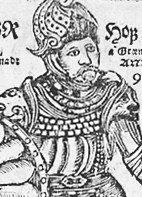
It is no more than about 300 km from Iceland to Greenland, and that there was a world here, was known long before Erik the Red went there. Eirik Raude stayed at Jæren, but he and his father went from Norway due murder, and settled in Iceland. Eirik came up in murder cases there too, and was convicted outlaw. Then he proceeded to Greenland and found West Greenland and made himself familiar with the country.
He came back to the Island, fighting with his old opponent, and lost. They were reconciled that Eirik had to leave Iceland. That same year, 986, came Eirik with a fleet of settlers to Greenland, 14 ships arrived. They took their settlements south of West Greenland, in the two villages called eastern parish and Western Settlement.
About this there is information in the writings of the Middle Ages, and from excavations done in our time. When the settlement was at its largest, was there 16 churches, 2 monastery and 280 farms in Greenland. The biggest farm was bispgården Gardar, where the big room was 36 m2 (388 sq ft) and a banquet hall was 130 m2 (1,399 sq ft) and where they had 100 caliper bound cattle.
The country became Christian in the year 1000, the Leiv Eiriksson, commissioned by Olav Tryggvason, and was later a separate diocese. After Eric's legal position is clear that newly constructed in Greenland was an independent free state. In the sagas there is also Greenland considered as a separate country.
In 1247 came a newly appointed bishop from Norway to Greenland, with orders from King Haakon IV Håkonsson that Greenlanders should not go to the king. In 1261 there were some farmenn back from Greenland with the message that Greenlanders had committed itself to paying tax to the king.
Bohuslän
Jämtland
Snorre Sturlasson writes in Heimskringla about, Ketil Jamt the son of Onund Earl of Sparbu in Trøndelag, he moved east over the ridge to people and livestock, and cleaned up Jämtland. In the saga of Egill Skallagrímsson he writes that the plundering of Harald Fairhair ascended many people including Jämtland.
According to Snorre, Jämtland had in Harald Fairhair's time an independent position. Under Haakon the Good gave Jämts in Norway under the King and he promised tax and Hakon put law and land rights for them. This joystick at the front in the 1000s. In Eric Haakonsson Earl of Lade's, time Jämtland was a part of lens division after the settlement of the great naval Battle of Svolder and Jämtland, Herjedalen, Rana, Båhuslen and Romsdal had fallen on Erik's brother Svein after agreement with the Swedish king, Olof Skötkonung. When Olav demanded tax of Jämtland, he didn't get it.
Jämtland received Christianity from the east as Trøndelag did. According to an inscription in Norwegian from the mid-1000s the country was Christianized by a man named Austmann Gudfastsson. Ecclesiastical heard country under the Archbishop of Uppsala some time before 1571. Also King Øystein Magnusson (1103-1122) made a claim against the Jämts, that they should go under the king of Norway.
Herjedalen
What about Herjedalen are told that the first settled there, was Herjulv Hornbrjot. He was noticed husband (standard bearer) with King Halfdan the Black, but came in disgrace and went to Svearike. There he became an outlaw and then he settled in Herjedalen, which then layd in Norway. This must have been around the year 850. Herjedalen became Christian in the years 1030 to 1060, and belonged to the diocese of Nidaros.
Finnmark and Lapland

Gjesvær in Nordkapp is mentioned in the Sagas (Heimskringla) as a northern harbor in the Viking Age, especially used by Vikings on the way to Bjarmaland (see Ottar from Hålogaland), and probably also for gathering food in the nearby seabird colony. Coastal areas of Finnmark were colonized by Norwegians beginning in the 10th century, and there are stories describing clashes with the Karelians. Border skirmishes between the Norwegians and Novgorodians continued until 1326, when the Treaty of Novgorod settled the issue.
From the 11th century Olaf III of Norway regarded the borders of Norway as reaching to the White Sea. The first Norwegians started moving to Finnmark in the 13th century. Vardøhus Fortress was erected by Norway in 1306 further east than today's land border by King Haakon V Magnusson, supporting Norwegian land ownership. This is the world's most northern fortress.
Kola (Murmansk)
By the 13th century, a need to formalize the border between the Novgorod Republic and the Scandinavian countries became evident.[12] The Novgorodians, along with the Karelians who came from the south, reached the coast of what now is Pechengsky District and the portion of the coast of Varangerfjord near the Voryema River, which now is a part of Norway.[12] The Sami population was forced to pay tribute.[12] The Norwegians, however, were also attempting to take control of these lands, resulting in armed conflicts.[12] In 1251, a conflict between the Karelians, Novgorodians and the servants of the king of Norway lead to the establishment of a Novgorodian mission in Norway.[12] Also in 1251, the first treaty with Norway was signed in Novgorod regarding the Sami lands and the system of tribute collections, making the Sami people pay tribute to both Novgorod and Norway.[12] By the terms of the treaty, Novgorodians could collect tribute from the Sami as far as Lyngen fjord in the west, while Norwegians could collect tribute on the territory of the whole Kola Peninsula except in the eastern part of Tersky Coast.[12] No state borders were established by the 1251 treaty.[12] At that time there were no permanent Norwegian settlements on the Kola Peninsula, except as late as the 1860s.
The treaty lead to a short period of peace, but the armed conflicts resumed soon thereafter.[12] Chronicles document attacks by the Novgorodians and the Karelians on Finnmark and northern Norway as early as 1271, and continuing well into the 14th century.[12] The official border between the Novgorod lands and the lands of Sweden and Norway was established by the Treaty of Nöteborg on August 12, 1323.[12] The treaty primarily focused on the Karelian Isthmus border and the border north of Lake Ladoga.[12]
Another treaty dealing the matters of the northern borders was the Treaty of Novgorod signed with Norway in 1326, which ended the decades of the Norwegian-Novgorodian border skirmishes in Finnmark.[13] Per the terms of this treaty, Norway relinquished all claims to the Kola Peninsula.[13] A signed agreement regarding the taxation of the Kola Peninsula and Finnmark.[14] No border line was drawn, creating a marchland where both countries held the right to taxation of the Sami people.[15] However, the treaty did not address the situation with the Sami people paying tribute to both Norway and Novgorod, and the practice continued until 1602.[13] While the 1326 treaty did not define the border in detail, it confirmed the 1323 border demarcation, which remained more or less unchanged for the next six hundred years, until 1920.[13]
End of the self-rule
After the extinction of the male lines of the perceived Fairhair dynasty in 1319, the throne of Norway passed through matrilineal descent to Magnus VII, who in the same year became elected as king of Sweden too. In 1343 Magnus had to abdicate as King of Norway in favour of his younger son, Haakon VI of Norway. The oldest son, Eric, was explicitly removed from the future line of succession of Norway. Traditionally Norwegian historians have interpreted this clear break with previous successions as stemming from dissatisfaction among the Norwegian nobility with Norway's junior position in the union. However it may also be the result of Magnus' dynastic policies. He had two sons and two kingdoms and might have wished they should inherit one each, rather than start battling over the inheritance. Magnus was at the same time attempting to secure Eric's future election as King of Sweden.
The Black Death of 1349–51 was a contributing factor to the decline of the Norwegian monarchy as the noble families and population in general were gravely affected. But the most devastating factor for the nobility and the monarchy in Norway was the steep decline in income from their holdings. Many farms were deserted and rents and taxes suffered. This left the Norwegian monarchy weakened in terms of manpower, noble support, defence ability and economic power.[16]The Black Death ended up depleting the Population By 65%, From roughly 350,000 to 125,000.[17]
After the death of Haakon VI of Norway in 1380, his son Olav IV of Norway succeeded to both the thrones of Norway and Denmark and also claimed the Kingdom of Sweden, holding its westernmost provinces already. Only after his death at the age of 17 his mother Margaret managed to oust their rival, king Albert, from Sweden, and thus united the three Scandinavian kingdoms in personal union under one crown, in the Kalmar Union. Olav's death extinguished yet one Norwegian male royal line; he was also the last Norwegian king to be born on Norwegian soil for the next 567 years.[16] After the death of Olav IV of Norway in 1387, the closest in line to the succession was the Swedish king Albert of Mecklenburg. However, his succession was politically unacceptable to the Norwegians and Danes. Next in line were the descendants of the Sudreim lineage, legitimate descendants of Haakon V of Norway's illegitimate, but recognized daughter Agnes Haakonardottir, Dame of Borgarsyssel. However, the candidate from this lineage renounced his claim to the throne in favour of Eric of Pomerania, Queen Margaret's favoured candidate. The succession right of this lineage resurfaced in 1448 after the death of King Christopher, but the potential candidate, Sigurd Jonsson, again renounced his candidature (see Sudreim claim). Eric's succession was one in a line of successions which did not precisely follow the laws of inheritance, but excluded one or a few undesirable heirs, leading to Norway formally becoming an elective kingdom in 1450.[18]
Starting with Margaret I of Denmark, the throne of Norway was held by a series of non-Norwegian kings usually perceived as Danish, who variously held the throne to more than one Scandinavian countries, or of all of them.
See also
Notes and references
Notes
- ^ The peak is conventionally taken to begin after the last phase of the unification during the reign of Saint Olav in the 1020s.
- ^ The empire was under Danish control from the Kalmar Union's beginning in 1397 and forward as the Danish colonial empire, but the possessions such as Iceland, Greenland and Faroe Islands remained Norwegian until the end of the Danish rule of Norway in 1814, when they then officially become a part of the Kingdom of Denmark.
- ^ This number is found by adding up the areas of Jämtland, Härjedalen, Bohuslän, Iceland, the Faroe Islands, Greenland, Shetland and Orkney. The entire area of Greenland was not effectively controlled by anyone at the time, however it is today under the Crown of Denmark and therefore would have been under the Crown of Norway.
- ^ As a result of the Norwegian victory in the Battle of Anglesey Sound in 1098 the Welsh considered the Norwegian soldiers as their liberators following Norway's victory against the Normans of England, and Magnus III regarded Anglesey as part of the Kingdom of the Isles and then took the island as a possession of Norway. Since the Norwegians never settled on the island, Anglesey reverted to Welsh control when Gruffudd ap Cynan returned from Ireland the year after in 1099.
References
- ↑ Thomas Madden, The New Concise History of the Crusades (Rowman and Littlefield, 2005), pp. 40–43.
- ↑ https://snl.no/Leiv_Eiriksson | (In Norwegian) edited by Professor Bjørn Bandlien on 02.15.17
- ↑ The Norwegian Domination and the Norse World, C.1100-c.1400 by Steinar Imsen p. 118-119
- ↑ The Norwegian Domination and the Norse World, C.1100-c.1400
- ↑ When Caithness Became Scottish
- ↑ Domination and Lordship: Scotland, 1070-1230
- ↑ The Northern Earldoms - Orkney and Caithness from AD 870 to 1470
- ↑ "Vikings in Scotland: An Archaeological Survey" by James Graham-Campbell and Colleen E. Batey (1998) p. 106-108
- ↑ "The Normans" ep. 01 by BBC, written and presented by Professor Robert Bartlett from the University of St. Andrews (2010)
- ↑ https://nbl.snl.no/Rollo_Gange-Rolv_Ragnvaldsson Written for the public Norwegian Encyclopedia SNL, by professor Claus Krag 02.13.09
- ↑ "Scandinavian Scotland" by B.E. Crawford (1987) p. 57 and 65
- 1 2 3 4 5 6 7 8 9 10 11 12 Administrative-Territorial Divisions of Murmansk Oblast, p. 17
- 1 2 3 4 Administrative-Territorial Divisions of Murmansk Oblast, p. 18
- ↑ Vassdal, Trond O. (3 August 2012). "Historisk sammendrag vedrørende riksgrensen Norge – Russland" (PDF) (in Norwegian). Norwegian Mapping and Cadastre Authority. Archived (PDF) from the original on 20 August 2012. Retrieved 20 August 2012.
- ↑ Johanson (1999): 15
- 1 2 A Short History of Norway https://archive.is/mU1jM
- ↑ Brothen, James A. "Population Decline and Plague in late medieval Norway". Annales de démographie historique (in French). 1996 (1): 137–149. doi:10.3406/adh.1996.1915.
- ↑ Hødnebø, Finn (ed.) (1974). Kulturhistorisk leksikon for nordisk middelalder, bind XVIII. Gyldendal norsk forlag. p. 691.
External links
- Oscar Albert Johnsen (1924). Noregsveldets undergang : Et utsyn og et opgjør : Nedgangstiden. Kristiania: Aschehoug.
- Jørn Sandnes (1971). Ødetid og gjenreisning : Trøndsk busetningshistorie ca. 1200–1600. Universitetsforlaget.
- Per Sveaas Andersen (1977). Samlingen av Norge og kristningen av landet : 800–1130. Universitetsforlaget.
- Aslak Bolt (1997). Aslak Bolts jordebok. Riksarkivet.
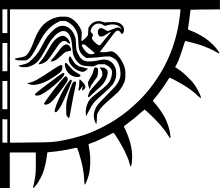
.svg.png)
